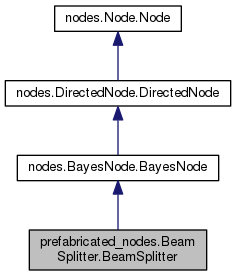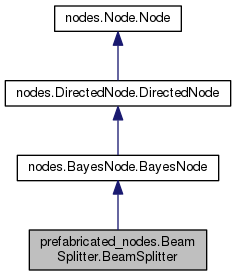|
| def | __init__ (self, id_num, name, in_nd1, in_nd2, tau_mag, tau_degs, rho_degs, num_of_comps, max_n_sum=10000) |
| |
| def | get_bs_amp_self (self, n1, n2, m1, m2) |
| |
| def | fill_trans_mat_and_st_names_of_nd (self, m1x, m2x, m1y, m2y, dry_run=False) |
| |
| def | get_expected_degen (self, m1x, m2x, m1y, m2y) |
| |
| def | __init__ (self, id_num, name="blank", size=2) |
| |
| def | set_potential (self, pot) |
| |
| def | resize (self, size) |
| |
| def | set_state_name (self, position, name) |
| |
| def | st_name_index (self, st_name) |
| |
| def | forget_all_evidence (self) |
| |
| def | get_active_states (self) |
| |
| def | set_active_states (self, states) |
| |
| def | set_state_names_to_product (self, list_of_iters, repeat=1, trim=False) |
| |
| def | __init__ (self, id_num, name="blank") |
| |
| def | add_parent (self, node) |
| |
| def | add_parents (self, node_list) |
| |
| def | remove_parent (self, node) |
| |
| def | has_parent (self, node) |
| |
| def | add_child (self, node) |
| |
| def | add_children (self, node_list) |
| |
| def | remove_child (self, node) |
| |
| def | has_child (self, node) |
| |
| def | undirect (self) |
| |
| def | get_markov_blanket (self) |
| |
| def | __init__ (self, id_num, name="blank") |
| |
| def | __lt__ (self, other) |
| |
| def | add_neighbor (self, node) |
| |
| def | remove_neighbor (self, node) |
| |
| def | has_neighbor (self, node) |
| |
The Constructor of this class builds a BayesNode that has a transition
matrix appropriate for a beam splitter.
The following is expected:
* the focus node has exactly two parent nodes,
* Both parent nodes are scalar-field nodes OR both parent nodes are
vector-field nodes.
M1 M2
\|/
|
/|\
N2 N1
all arrows pointing downward
(mnemonic: N for New beams=modes)
In the scalar-field case, M2, M1, N1 and N2 are the numbers of photons
that pass through the two incoming and the two outgoing ports. In this
case, Quantum Fog gives names of the form (N1,N2) to the states of the
beam-splitter.
In the vector-field case, M2, M1, N1 and N2 also correspond in a 1-1
fashion to the incoming and outgoing ports, but instead of being
non-negative integers, they are 2-component vectors. For example,
M1 = (M1x, M1y), where M1x and M1y are non-negative integers. In this
case, Quantum Fog gives names of the form ((N1x, N1y), (N2x, N2y)) to
the states of the beam-splitter.
tau and rho, satisfying |tau|^2 + |rho|^2 = 1, are the complex
transmission and reflection coefficients of the beam-splitter. You must
enter tau_mag = the magnitude tau, tau_degs = phase of tau in degrees,
and rho_degs = phase of rho in degrees. These 3 parameters completely
specify the complex numbers tau and rho.
Consider the scalar-field case, for example. Frequently, nets which
contain a beam-splitter node are such that we know what is the maximum
number of photons that will ever enter the beam-splitter. For example,
suppose that a net starts with 2 photons in its root nodes, and that for
one of the input states (M1, M2) of the beam-splitter, M1 + M2 = 3. Then
the list of states of the beam-splitter node would be forced to include
all states with N1 + N2 = 3. Or would it? Clearly, such states would
never occur in any of the possible stories of the net. So if we were to
exclude such states from the list of states of the beam-splitter node,
the physical predictions of the net (that is, the stories with non-zero
amplitude and their amplitudes) would still be the same. That's where
the input parameter 'max_n_sum' comes in. In the scalar case, Quantum
Fog lists those and only those states (N1, N2) for which N1 + N2 <=
max_n_sum. In our example, we could set 'max_n_sum' to 2 and thus
exclude states with N1 + N2 = 3. Of course, excluding some states would
cause the Total Probability sum_x P(x|input states) for some input
states to be different from 1. But the physical predictions of the net
would not change, and we would save memory by excluding unused baggage
from the transition matrix.
In the vector-field case, Quantum Fog lists those and only those states
((N1x, N1y), (N2x, N2y)) for which N1x + N1y+ N2x+ N2y <= max_n_sum
More information about beam splitter nodes can be found in the documents
entitled "Quantum Fog Manual", and "Quantum Fog Library Of Essays" that
are included with the legacy QFog.
Attributes
----------
num_of_comps : int
number of components, equals 1 for scalar case and 2 for vector case.
tau_mag : float
tau_degs : float
rho_degs : float
max_n_sum : int
true_max_n_sum : int
potential : Potential
active_states : list[int]
clique : Clique
size : int
state_names : list[str]
children : set[BayesNode]
neighbors : set[BayesNode]
parents : set[BayesNode]
id_num : int
topo_index : int
name : str
visited : bool 



 Public Member Functions inherited from nodes.BayesNode.BayesNode
Public Member Functions inherited from nodes.BayesNode.BayesNode Public Member Functions inherited from nodes.DirectedNode.DirectedNode
Public Member Functions inherited from nodes.DirectedNode.DirectedNode Public Member Functions inherited from nodes.Node.Node
Public Member Functions inherited from nodes.Node.Node Public Attributes inherited from nodes.BayesNode.BayesNode
Public Attributes inherited from nodes.BayesNode.BayesNode Public Attributes inherited from nodes.DirectedNode.DirectedNode
Public Attributes inherited from nodes.DirectedNode.DirectedNode Public Attributes inherited from nodes.Node.Node
Public Attributes inherited from nodes.Node.Node Properties inherited from nodes.BayesNode.BayesNode
Properties inherited from nodes.BayesNode.BayesNode 1.8.11
1.8.11